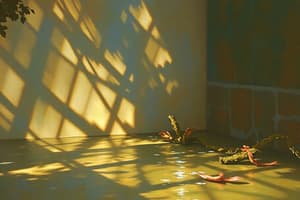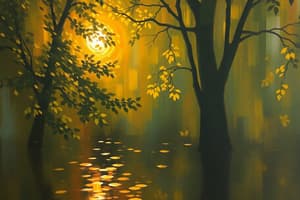Podcast
Questions and Answers
What is the main property of light responsible for the formation of shadows and pinhole images?
What is the main property of light responsible for the formation of shadows and pinhole images?
- Dispersion
- Absorption
- Reflection (correct)
- Refraction
On which type of surfaces does reflection mainly occur?
On which type of surfaces does reflection mainly occur?
- Opaque surfaces
- Transparent surfaces
- Rough surfaces
- Mirror surfaces (correct)
What is the imaginary line that is perpendicular to the reflecting surface called?
What is the imaginary line that is perpendicular to the reflecting surface called?
- Tangential
- Parallel
- Normal (correct)
- Orthogonal
What happens to the shadow formed when an opaque object is placed between a point light source and a screen?
What happens to the shadow formed when an opaque object is placed between a point light source and a screen?
What is the relationship between the angle of incidence and the angle of reflection?
What is the relationship between the angle of incidence and the angle of reflection?
What is the form of energy that makes objects visible and is responsible for the sense of sight?
What is the form of energy that makes objects visible and is responsible for the sense of sight?
What type of shadow is formed by the opaque object when it is larger than the light source?
What type of shadow is formed by the opaque object when it is larger than the light source?
What is the light shadow formed by the object called?
What is the light shadow formed by the object called?
What are the characteristics of the shadow formed when an opaque object is placed between a point light source and a screen?
What are the characteristics of the shadow formed when an opaque object is placed between a point light source and a screen?
What happens when an opaque object is placed between the light source and the screen?
What happens when an opaque object is placed between the light source and the screen?
What type of shadow is formed by the object when it is smaller than the light source?
What type of shadow is formed by the object when it is smaller than the light source?
What is the term for the dark shadow formed by an opaque object?
What is the term for the dark shadow formed by an opaque object?
What type of shadow is formed by the object when it is exactly the same size as the light source?
What type of shadow is formed by the object when it is exactly the same size as the light source?
What is the term for the light shadow formed by an opaque object?
What is the term for the light shadow formed by an opaque object?
What are the two patches formed when an opaque object is placed between a point light source and a screen?
What are the two patches formed when an opaque object is placed between a point light source and a screen?
What happens to a shadow when an opaque object that is much larger than the light source is placed between them?
What happens to a shadow when an opaque object that is much larger than the light source is placed between them?
Flashcards are hidden until you start studying
Study Notes
Light is a form of energy that makes objects visible and is responsible for the sense of sight. It is emitted from a source such as the Sun and is usually visible to the human eye as visible light. In this article, we will be focusing on the subtopics of reflection of light, reflection of light, and its properties, shadows, and its formation.
Reflection of Light: Reflection occurs when a ray of light falls on a surface and bounces back. This phenomenon is known as reflection. The laws of reflection states that when a ray of light reflects off a surface, the angle of incidence is equal to the angle of reflection. This property of light is responsible for the formation of shadows and pinhole image.
Reflection of Light: Reflection occurs mainly on mirror surfaces as incident light gets reflected when it falls on a surface with shiny and glossy properties. The angle of incidence is the angle between the incident ray and the normal, and the angle of reflection is the angle between the reflected ray and the normal. The normal is an imaginary line that is perpendicular to the reflecting surface.
Reflection of Light: When an opaque object is placed between a point light source and a screen, the shadow formed is (i) Uniformly dark (ii) Sharp at the edges and (iii) Of the same shape as the object. When an opaque object, larger than the light source, is placed between the light source and the screen, two patches are formed; umbra and penumbra. The umbra is the dark shadow formed by the object, and the penumbra is the light shadow formed by the object.
Reflection of Light: When an opaque object is placed between a point light source and a screen, the shadow formed is (i) Uniformly dark (ii) Sharp at the edges and (iii) Of the same shape as the object. When an opaque object, larger than the light source, is placed between the light source and the screen, two patches are formed; umbra and penumbra. The umbra is the dark shadow formed by the object, and the penumbra is the light shadow formed by the object.
Reflection of Light: When an opaque object is placed between a point light source and a screen, the shadow formed is (i) Uniformly dark (ii) Sharp at the edges and (iii) Of the same shape as the object. When an opaque object, larger than the light source, is placed between the light source and the screen, two patches are formed; umbra and penumbra. The umbra is the dark shadow formed by the object, and the penumbra is the light shadow formed by the object.
Reflection of Light: When an opaque object is placed between a point light source and a screen, the shadow formed is (i) Uniformly dark (ii) Sharp at the edges and (iii) Of the same shape as the object. When an opaque object, larger than the light source, is placed between the light source and the screen, two patches are formed; umbra and penumbra. The umbra is the dark shadow formed by the object, and the penumbra is the light shadow formed by the object.
Reflection of Light: When an opaque object is placed between a point light source and a screen, the shadow formed is (i) Uniformly dark (ii) Sharp at the edges and (iii) Of the same shape as the object. When an opaque object, larger than the light source, is placed between the light source and the screen, two patches are formed; umbra and penumbra. The umbra is the dark shadow formed by the object, and the penumbra is the light shadow formed by the object.
Reflection of Light: When an opaque object is placed between a point light source and a screen, the shadow formed is (i) Uniformly dark (ii) Sharp at the edges and (iii) Of the same shape as the object. When an opaque object, larger than the light source, is placed between the light source and the screen, two patches are formed; umbra and penumbra. The umbra is the dark shadow formed by the object, and the penumbra is the light shadow formed by the object.
Reflection of Light: When an opaque object is placed between a point light source and a screen, the shadow formed is (i) Uniformly dark (ii) Sharp at the edges and (iii) Of the same shape as the object. When an opaque object, larger than the light source, is placed between the light source and the screen, two patches are formed; umbra and penumbra. The umbra is the dark shadow formed by the object, and the penumbra is the light shadow formed by the object.
Reflection of Light: When an opaque object is placed between a point light source and a screen, the shadow formed is (i) Uniformly dark (ii) Sharp at the edges and (iii) Of the same shape as the object. When an opaque object, larger than the light source, is placed between the light source and the screen, two patches are formed; umbra and penumbra. The umbra is the dark shadow formed by the object, and the penumbra is the light shadow formed by the object.
Reflection of Light: When an opaque object is placed between a point light source and a screen, the shadow formed is (i) Uniformly dark (ii) Sharp at the edges and (iii) Of the same shape as the object. When an opaque object, larger than the light source, is placed between the light source and the screen, two patches are formed; umbra and penumbra. The umbra is the dark shadow formed by the object, and the penumbra is the light shadow formed by the object.
Reflection of Light: When an opaque object is placed between a point light source and a screen, the shadow formed is (i) Uniformly dark (ii) Sharp at the edges and (iii) Of the same shape as the object. When an opaque object, larger than the light source, is placed between the light source and the screen, two patches are formed; umbra and penumbra. The umbra is the dark shadow formed by the object, and the penumbra is the light shadow formed by the object.
Reflection of Light: When an opaque object is placed between a point light source and a screen, the shadow formed is (i) Uniformly dark (ii) Sharp at the edges and (iii) Of the same shape as the object. When an opaque object, larger than the light source, is placed between the light source and the screen, two patches are formed; umbra and penumbra. The umbra is the dark shadow formed by the object, and the penumbra is the light shadow formed by the object.
Reflection of Light: When an opaque object is placed between a point light source and a screen, the shadow formed is (i) Uniformly dark (ii) Sharp at the edges and (iii) Of the same shape as the object. When an opaque object, larger than the light source, is placed between the light source and the screen, two patches are formed; umbra and penumbra. The umbra is the dark shadow formed by the object, and the penumbra is the light shadow formed by the object.
Reflection of Light: When an opaque object is placed between a point light source and a screen, the shadow formed is (i) Uniformly dark (ii) Sharp at the edges and (iii) Of the same shape as the object. When an opaque object, larger than the light source, is placed between the light source and the screen, two patches are formed; umbra and penumbra. The umbra is the dark shadow formed by the object, and the penumbra is the light shadow formed by the object.
Reflection of Light: When an opaque object is placed between a point light source and a screen, the shadow formed is (i) Uniformly dark (ii) Sharp at the edges and (iii) Of the same shape as the object. When an opaque object, larger than the light source, is placed between the light source and the screen, two patches are formed; umbra and penumbra. The umbra is the dark shadow formed by the object, and the penumbra is the light shadow formed by the object.
Reflection of Light: When an opaque object is placed between a point light source and a screen, the shadow formed is (i) Uniformly dark (ii) Sharp at the edges and (iii) Of the same shape as the object. When an opaque object, larger than the light source, is placed between the light source and the screen, two patches are formed; umbra and penumbra. The umbra is the dark shadow formed by the object, and the penumbra is the light shadow formed by the object.
Reflection of Light: When an opaque object is placed between a point light source and a screen, the shadow formed is
Studying That Suits You
Use AI to generate personalized quizzes and flashcards to suit your learning preferences.




